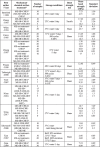The Effect of Mechanical and Chemical Surface Preparation Methods on the Bond Strength in Repairing the Surface of Metal-Ceramic Crowns with Composite Resin: a Systematic Review and Meta-Analysis
- PMID: 32952686
- PMCID: PMC7482688
- DOI: 10.26574/maedica.2020.15.2.206
The Effect of Mechanical and Chemical Surface Preparation Methods on the Bond Strength in Repairing the Surface of Metal-Ceramic Crowns with Composite Resin: a Systematic Review and Meta-Analysis
Abstract
The aim of this study was to find the most effective surface preparation methods to enhance the bond strength between the composite resin and surface remaining from ceramic fracture. In this systematic review and meta-analysis, 39 studies were examined. The information related to the studies was extracted and categorized based on the type of the substrate material and applying or not applying thermal cycles (p<0.05). In the meta-analysis of substrate metal-ceramic samples without aging, application of air abrasion resulted in a significant increase of the bond strength to composite resin when using chemical compounds of the group without the mentioned functional monomers. Application of mechanical and chemical surface preparation methods can result in enhanced bond strength of the composite to the substrate material, which depends on the type of substrate material.
Figures

























References
-
- Furuchi M, Oshima A, Ishikawa Y, et al. Effect of metal priming agents on bond strength of resin-modified glass ionomers joined to gold alloy. Dent Mater J. 2007;5:728–732. - PubMed
-
- Anusavice K, Kakar K, Ferree N. Which mechanical and physical testing methods are relevant for predicting the clinical performance of ceramic‐based dental prostheses? Clin Oral Implants Res. 2007;3:218–231. - PubMed
-
- dos Santos JG, Fonseca RG, Adabo GL, dos Santos Cruz CA. Shear bond strength of metal-ceramic repair systems. J Prosthet Dent. 2006;3:165–173. - PubMed
-
- Galiatsatos AA. An indirect repair technique for fractured metal-ceramic restorations: a clinical report. J Prosthet Dent. 2005;4:321–323. - PubMed
-
- Haselton DR, Diaz-Arnold AM, Dunne JT. Shear bond strengths of 2 intraoral porcelain repair systems to porcelain or metal substrates. J Prosthet Dent. 2001;5:526–531. - PubMed
Publication types
LinkOut - more resources
Full Text Sources
